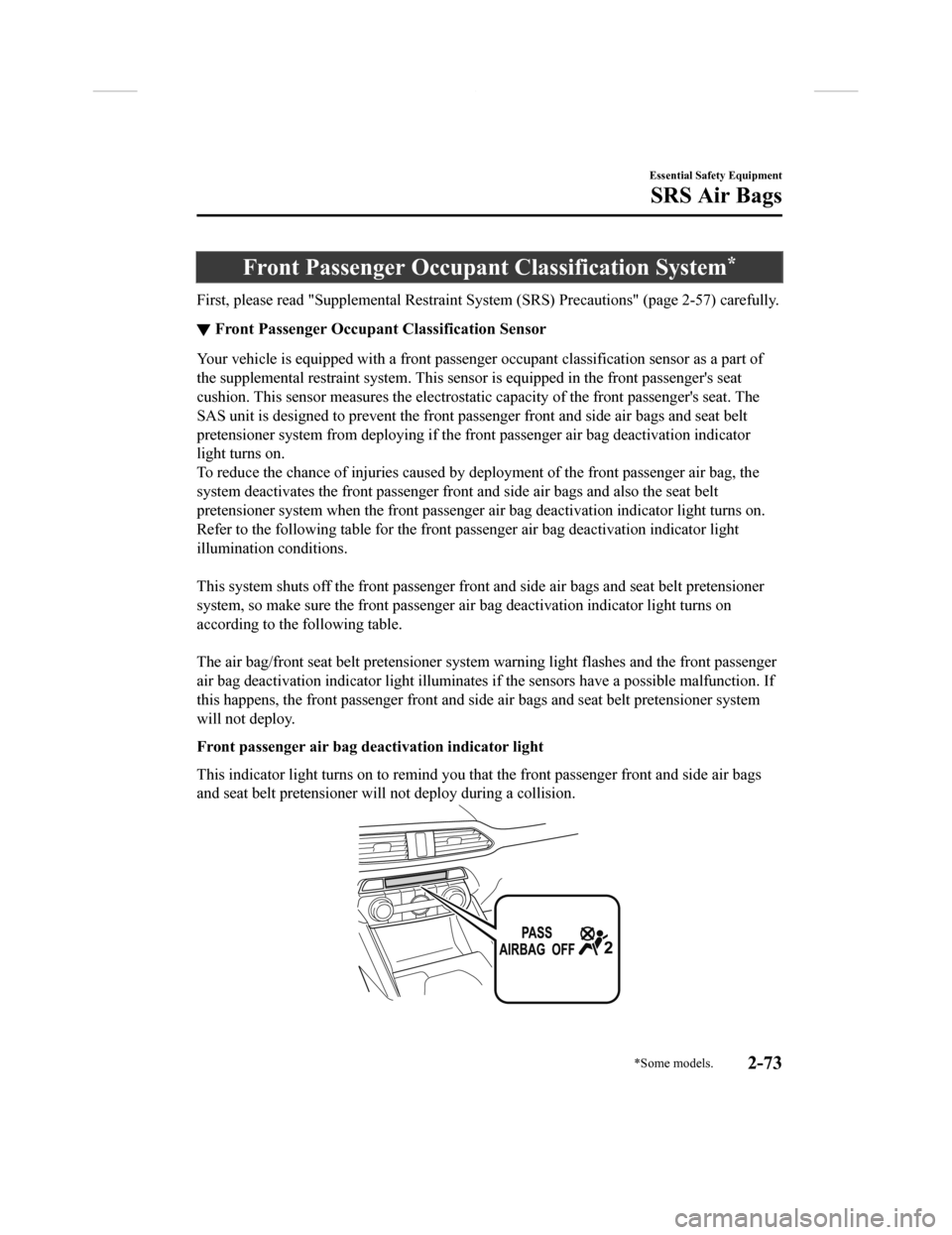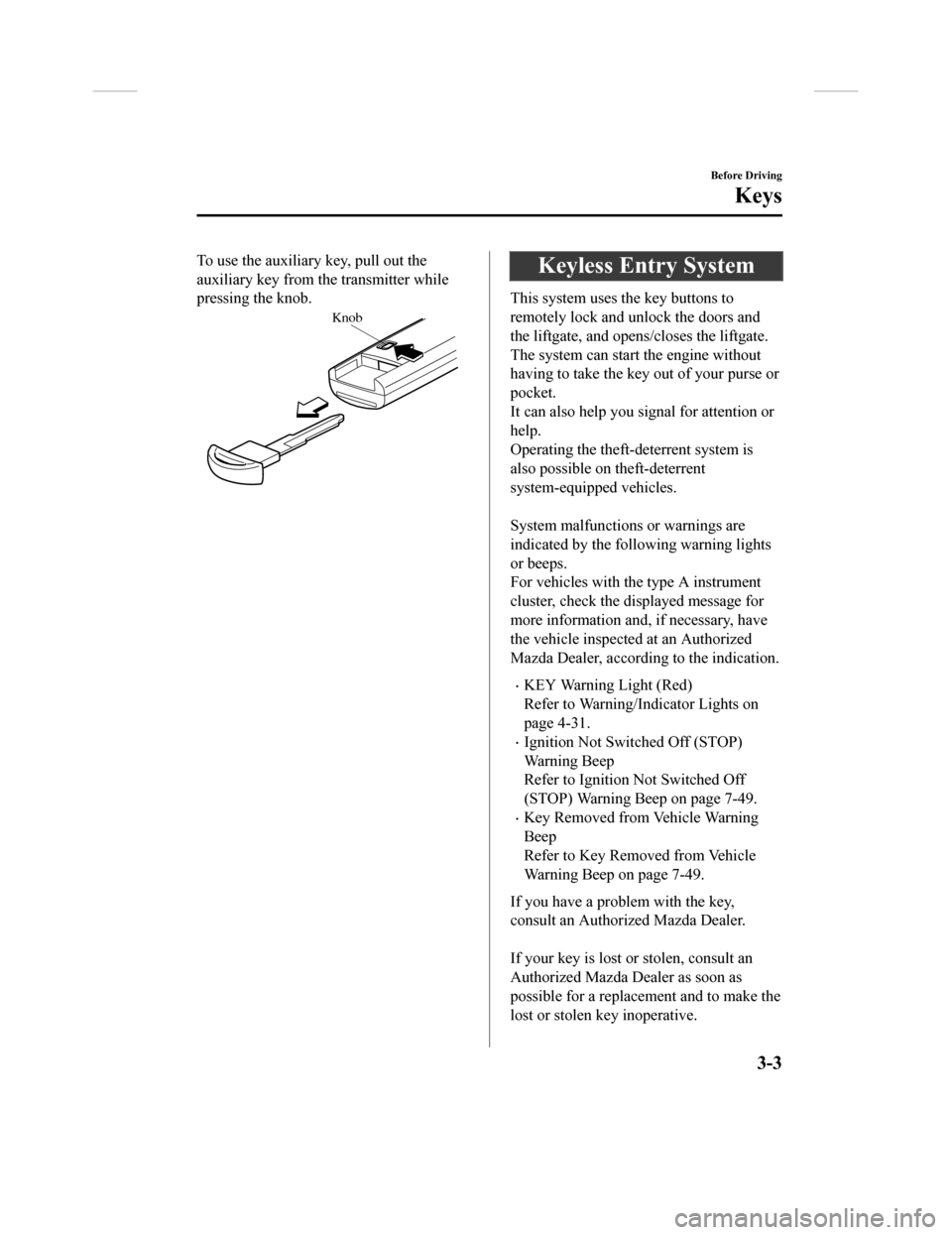eng MAZDA MODEL CX-9 2018 (in English) Service Manual
[x] Cancel search | Manufacturer: MAZDA, Model Year: 2018, Model line: MODEL CX-9, Model: MAZDA MODEL CX-9 2018Pages: 640
Page 82 of 640

SRS Air Bag Deployment Criteria
This chart indicates the applicable SRS equipment that will deploy depending on the type of
collision.
(The illustrations are the representative cases of collisions.)
SRS equip- ment Types of collision
A severe frontal/near frontal colli- sion A severe side colli-
sion
*2A roll-over/nearroll-over*3A rear collision
Front seat
belt preten- sioner X*1 (both sides)
X*1 (impact side
only) X*1 (both sides)
No air bag and
front seat belt pre-
tensioner will be
activated in a rear
collision.
Driver air
bag X
Front pas- senger air bag X
*1
Side air bag
X*1 (impact side
only)
Curtain air bag X (impact side on-
ly) X (both sides)
X: The SRS air bag equipment is
designed to deploy in a collision.*1(With Front Passenger Occupant Classification System)
The front passenger front and side air bags and the seat belt pretensioner are designed to deploy when the front
passenger occupant cla ssification sensor detects a passenger si tting on the front passenger's seat.
*2 In a side collision, the seat belt pretensioners and the side/curtain air bags deploy (only on the side in which the
collision occurs).
*3 (With Front Passenger Occupant Classification System)
In a roll-over accident, the s eat belt pretensioners and the cu rtain air bags deploy.
NOTE
In a frontal offset collision, the equipp ed air bags and pretensioners may all deploy
depending on the direction, angle, and rate of impact.
Essential Safety Equipment
SRS Air Bags
2-70
CX-9_8GC3-EA-17G_Edition1 2017-5-29 10:13:38
Page 84 of 640

Limitations to side collision detection:
The following illustrations are e xamples of side collisions that may not be detected as
severe enough to deploy the SRS air bag equipment.
Side impacts involving trees or poles Side impacts with two-wheeled vehicles
Roll-over (Without Front Passenger Occupant Classification System)
(With Front Passenger Occupa
nt Classification System)
Limitations to roll-over detection:
The following illustration is an example of an accident that may not be detected as a
roll-over accident. Therefore, the front seat belt pretensioner s and curtain air bags may not
deploy.
Pitch end over end
Essential Safety Equipment
SRS Air Bags
2-72
CX-9_8GC3-EA-17G_Edition1 2017-5-29 10:13:38
Page 85 of 640

Front Passenger Occupant Classification System*
First, please read "Supplemental Restraint System (SRS) Precautions" (page 2-57) carefully.
▼Front Passenger Occupant Classification Sensor
Your vehicle is equipped with a front passenger occupant classi
fication sensor as a part of
the supplemental restraint system. This sensor is equipped in t he front passenger's seat
cushion. This sensor measures th e electrostatic capacity of the front passenger's seat. The
SAS unit is designed to prevent the front passenger front and s ide air bags and seat belt
pretensioner system from deployi ng if the front passenger air bag deactivation indicator
light turns on.
To reduce the chance of injuries caused by deployment of the front passenger air bag, the
system deactivates the front passenger front and side air bags and also the seat belt
pretensioner system when the front passenger air bag deactivati on indicator light turns on.
Refer to the following table for the front passenger air bag deactivation indicator light
illumination conditions.
This system shuts off the front passenger front and side air ba gs and seat belt pretensioner
system, so make sure the front passenger air bag deactivation indicator light turns on
according to the following table.
The air bag/front seat belt pretensioner system warning light f lashes and the front passenger
air bag deactivation indicator light illuminates if the sensors have a possible malfunction. If
this happens, the front passenger front and side air bags and s eat belt pretensioner system
will not deploy.
Front passenger air bag deactivation indicator light
This indicator light turns on to r emind you that the front passenger front and side air bags
and seat belt pretensioner will not deploy during a collision.
Essential Safety Equipment
SRS Air Bags
*Some models.2-73
CX-9_8GC3-EA-17G_Edition1 2017-5-29 10:13:38
Page 86 of 640

If the front passenger occupant classification sensor is normal, the indicator light turns on
when the ignition is switched ON. The light turns off after a few seconds. Then, the
indicator light turns on or is off under the following conditio ns:
Front passenger air bag deactiva tion indicator light on/off condition chart
Condition detected by the front
passenger occupant classifica- tion system Front passenger air
bag deactivation indi- cator light Front passenger front
and side air bags Front passenger seat
belt pretensioner sys- tem
Empty (Not occupied) OnDeactivated Deactivated
A child less than 1 year old is
seated in a child-restraint system On
Deactivated Deactivated
Child
*1On or off Deactivated or ready Deactivated or ready
Adult
*2Off Ready Ready
*1 The occupant classification sens or may not detect a child seated on the seat, in a child-restraint system, or a
junior seat depending on the ch ild's physical size and seated posture.
*2 If a smaller adult sits on the front passenger seat, the sensors might detect the person as being a child
depending on the person's physique.
The curtain air bag is ready for inflating regardless of what the front passenger air bag
deactivation indicator light on/off condition chart indicates.
If the front passenger air bag deactivation indicator light doe s not turn on when the ignition
is switched ON and does not turn on as indicated in the front p assenger air bag deactivation
indicator light on/off condition chart, do not allow an occupan t to sit in the front passenger
seat and consult an Authorized M azda Dealer as soon as possible. The system may not work
properly in an accident.
WA R N I N G
Do not allow an occupant in the front passenger's seat to sit with a posture which makes it
difficult for the front passenger occupant classification sensor to detect the occupant
correctly:
Sitting in the front passenger's seat with a posture which makes it difficult for the front
passenger occupant classification sensor to dete ct the occupant correctly is dangerous. If the
front passenger occupant classification sensor ca nnot detect the occupant sitting on the front
passenger's seat correctly, the front passenge r front and side air bags and pretensioner
system may not operate (non-deploy) or they may operate (deploy) accidentally. The front
passenger will not have the su pplementary protection of the air bags or the accidental
operation (deployment) of the air bags could result in serious injury or death.
Under the following conditions, the front passe nger occupant classification sensor cannot
detect a passenger sitting on the front passe nger's seat correctly and the deployment/
non-deployment of the air bags cannot be contro lled as indicated in the front passenger air
bag deactivation indicator light on /off condition chart. For example:
Essential Safety Equipment
SRS Air Bags
2-74
CX-9_8GC3-EA-17G_Edition1 2017-5-29 10:13:38
Page 87 of 640

A front passenger is seated as shown in the following
figure:
A rear passenger pushes up on the front passenger seat with their feet.
Luggage or other items placed under the front passenger seat or between the front
passenger seat and driver seat that push up the front passenger seat bottom.
An object, such as a seat cushion, is put on the front passenger's seat or between the
passenger's back and the seatback.
A seat cover is put on the front passenger's seat.
Luggage or other items are placed on the seat with the child in the child-restraint system.
A rear passenger or luggage push or pull down on the front passenger seatback.
Luggage or other items are placed on the seatback or hung on the head restraint.
The seat is washed.
Liquids are spilled on the seat.
The front passenger seat is moved backward, pushing into luggage or other items placed
behind it.
The front passenger seatback contacts the rear seat.
Luggage or other items are placed between the front passenger seat and driver seat.
An electric device is put on the front passenger's seat.
An additional electrical device, such as a seat warmer is installed to the surface of the front
passenger seat.
Essential Safety Equipment
SRS Air Bags
2-75
CX-9_8GC3-EA-17G_Edition1 2017-5-29 10:13:38
Page 88 of 640

The front passenger front and side air bags and seat belt pretensioner systems will deactivate
if the front passenger air bag deactivation indicator light turns on.
CAUTION
To assure proper deployment of the front air bag and to prevent damage to the sensor in
the front seat cushion:
Do not place sharp objects on the front seat cushion or leave heavy luggage on them.
Do not spill any liquids on the front seats or under the front seats.
To allow the sensors to function properly, always perform the following:
Adjust the front seats as far back as possibl e and always sit upright against the seatbacks
with seat belts worn properly.
If you place your child on the front passenger seat, secure the child-restraint system
properly and slide the front passenger seat as far back as possible (page 2-44).
NOTE
•The system requires about 10 seconds to alte rnate between turning the front passenger
front and side air bags and seat belt pretensioner system on or off.
•The front passenger air bag deactivation indicato r light may turn on repeatedly if luggage
or other items are put on the front passenger seat, or if the temperature of the vehicle's
interior changes suddenly.
•The front passenger air bag deactivation indicato r light may turn on for 10 seconds if the
electrostatic capacity on the front passenger seat changes.
•The air bag/front seat belt pretensioner system warning light might turn on if the front
passenger seat receives a severe impact.
•If the front passenger air bag deactivation indicator light does not turn on after installing
a child-restraint system on the front passenger seat, first, re-install your child-restraint
system according to the procedure in this owner's manual. Then, if the front passenger air
bag deactivation indicator light still does not tu rn on, install the child-restraint system on
the rear seat and consult an Authorized Mazda Dealer as soon as possible.
•If the front passenger air bag deactivation i ndicator light turns on when an occupant is
seated directly in the front passenger seat, have the passenger re-adjust their posture by
sitting with their feet on the floor, and th en re-fastening the seat belt. If the front
passenger air bag deactivation i ndicator light remains turned on, move the passenger to
the rear seat. If sitting in the rear seat is no t possible, slide the front passenger seat as far
back as possible. Consult an Authorized Mazda Dealer as soon as possible.
Essential Safety Equipment
SRS Air Bags
2-76
CX-9_8GC3-EA-17G_Edition1 2017-5-29 10:13:38
Page 89 of 640

Constant Monitoring
The following components of the air bag systems are monitored by a diagnostic system:
•Front air bag sensors
•Crash sensors, and diagnostic module (SAS unit)
•Side crash sensors
•Air bag modules
•Front seat belt pretensioners
•Air bag/Front seat belt pretensioner system warning light
•Related wiring
(With Front Passenger Occupa nt Classification System)
•Front passenger occupant classification sensor
•Front passenger occupant classification module
•Front passenger air bag deactivation indicator light
The diagnostic module continuously monitors the system's readin ess. This begins when the
ignition is switched ON and contin ues while the vehicle is being driven.
Essential Safety Equipment
SRS Air Bags
2-77
CX-9_8GC3-EA-17G_Edition1 2017-5-29 10:13:38
Page 91 of 640

3Before Driving
Use of various features, including keys, doors, mirrors and windows.
Keys.................................................... 3-2 Keys.............................................. 3-2
Keyless Entry System................... 3-3
Advanced Keyless Entry
System...............................................3-10 Advanced Keyless Entry System
*.....
.................................................... 3-10
Operational Range...................... 3-11
Doors and Locks.............................. 3-12 Door Locks................................. 3-12
Liftgate....................................... 3-21
Fuel and Emission........................... 3-29 Fuel and Engine Exhaust
Precautions................................. 3-29
Fuel-Filler Lid and Cap.............. 3-32
Steering Wheel................................. 3-34 Steering Wheel....... .................... 3-34
Mirrors............................................. 3-35 Mirrors........................................ 3-35
Windows........................................... 3-38 Power Windows..........................3-38
Moonroof
*.................................. 3-41
Security System............................... 3-44
Modification and Add-On
Equipment...................................3-44
Immobilizer System....................3-44
Theft-Deterrent System
*.............3-46
Driving Tips..................................... 3-48 Break-In Period.......................... 3-48
Saving Fuel and Protection of the
Environment............................... 3-48
Hazardous Driving.... ..................3-49
Floor Mat.................................... 3-50
Rocking the Vehicle....................3-50
Winter Driving............................3-51
Driving In Flooded A rea............ 3-53
Overloading................................ 3-53
Driving on Uneven Road............ 3-54
Turbocharger Information.......... 3-55
Towing.............................................. 3-56 Trailer Towing (U.S.A. and
Canada)....................................... 3-56
Recreational Towing................... 3-64
*Some models.3-1
CX-9_8GC3-EA-17G_Edition1 2017-5-29 10:13:38
Page 93 of 640

To use the auxiliary key, pull out the
auxiliary key from th e transmitter while
pressing the knob.
Knob
Keyless Entry System
This system uses the key buttons to
remotely lock and unlock the doors and
the liftgate, and opens/closes the liftgate.
The system can start the engine without
having to take the key out of your purse or
pocket.
It can also help you signal for attention or
help.
Operating the theft-deterrent system is
also possible on theft-deterrent
system-equipped vehicles.
System malfunctions or warnings are
indicated by the following warning lights
or beeps.
For vehicles with the type A instrument
cluster, check the displayed message for
more information and, if necessary, have
the vehicle inspected at an Authorized
Mazda Dealer, according to the indication.
•KEY Warning Light (Red)
Refer to Warning/Indicator Lights on
page 4-31.
•Ignition Not Switched Off (STOP)
Warning Beep
Refer to Ignition Not Switched Off
(STOP) Warning Beep on page 7-49.
•Key Removed from Vehicle Warning
Beep
Refer to Key Removed from Vehicle
Warning Beep on page 7-49.
If you have a problem with the key,
consult an Authorized Mazda Dealer.
If your key is lost or stolen, consult an
Authorized Mazda Dealer as soon as
possible for a replacement and to make the
lost or stolen k ey inoperative.
Before Driving
Keys
3-3
CX-9_8GC3-EA-17G_Edition1 2017-5-29 10:13:38
Page 98 of 640

Power liftgate button*
To open/close the liftgate, press the power
liftgate button for one second or more with
the liftgate in the fully closed/open
position.
The hazard warning lights flash twice and
the liftgate opens/closes after the beep
sounds.
Panic button
If you witness from a distance someone
attempting to break into or damage your
vehicle, press and hold the panic button to
activate the vehicle's alarm. Call
emergency services if necessary.
NOTE
The panic button will work whether any
door or the liftgate is open or closed.
(Turning on the alarm)
Pressing the panic button for 1 second or
more will trigger the alarm for about 2
minutes and 30 seconds, and the following
will occur:
•The horn sounds intermittently.
•The hazard warning lights flash.
(Turning off the alarm)
The alarm stops by pressing any button on
the key.
▼ Operational Range
The system operates only when the driver
is in the vehicle or within operational
range while the key is being carried.
Starting the Engine
NOTE
•Starting the engine may be possible even
if the key is outside of the vehicle and
extremely close to a door and window,
however, always start the engine from
the driver's seat.
If the vehicle is started and the key is not
in the vehicle, the vehic
le will not restart
after it is shut off and the ignition is
switched to off.
•The luggage compartment is out of the
assured operational range, however, if
the key (transmitter) is operable the
engine will start.
Before Driving
Keys
3-8*Some models.
CX-9_8GC3-EA-17G_Edition1 2017-5-29 10:13:38